Similar presentations:
Development and Simulation
1. simSIMD
Timur KelinsimSIMD
Development and Simulation
Framework for Application Specific
Vector Processor
Cambridge 2019
2. Contents
Overview
System Component: EU
System Component: DM
System Component: XBAR
System Component: Streaming Unit
System Component: Scalar Infrastructure
Program Execution
3. Contents
“Design by Simulation” Strategy
Hardware Considerations
Structure of the Simulator Software
Tests and Examples
ToDo’s and Plans
References
4. Overview
OVERVIEW5. Objectives
• Develop a framework and building blocks forthe application specific vector processor, make
simulation software.
– Simplify the development of the hardware
architecture which performs operations on the
data structures of finite length (vectors)
• signal processing - OFDM symbols, code blocks
• cryptography - cipher blocks
• networking - data packets
6. Objectives
• Framework should provide unified approachfor the development of the functional
components: Execution Units (EU) and Data
Memories (DM) as well as for their
interoperation
– Specific set and configuration of the functional
units are identified by the target application
7. Objectives
• Elaborate development and simulation methodology ofthe hardware architecture from system specifications
(algorithms) and throughput requirements
• Follow top-down development and optimization
strategy
– Area: improvement of the utilization rate of the processing
blocks and storage elements (RAMs)
– Throughput: datapath is elaborated at the stage of the
architecture development
– Power
– Non-recurring engineering (NRE) resources and risks
8. Objectives
• Employ SystemC– Short simulation-analysis-update cycle which allows for
simulation driven development and optimization
– Cycle accurate simulation for the vector core to obtain
realistic timing and throughput estimates at the earlier stages
– High level of abstraction for Vector Core preferences, runtime
configuration and status to stay focused on the architectural
tasks
– Large ecosystem of C/C++ libraries for data manipulation and
processing allows for top-down development approach: from
high level processing functions down to elementary
arithmetic operations
– Allows for integration into the existing simulation workflows
– Open source
9. Block Diagram
10. Components in Brief
• Vector Core functions– Performing vector computations in accordance to
the configuration supplied from the Scalar Core
– Generation of the events at the different stages of
the execution of the vector operations
• Synchronization of the processing threads
– Update of the statuses of the vector operations
• Data dependent processing
– Sequencing of the vector operations
11. Components in Brief
• Vector Core components– Data Memories (DM): temporary storage of the
vectors.
• A set of Address Generators (AG) associated with each
DM allows for flexible addressing/fetching of the
elements of the vector.
– Execution Units (EU): perform successive
processing of the elements of the vectors.
• This part of the Vector Core is specific for target
application
12. Components in Brief
– Streaming Devices: interfacing Vector Core withthe external devices
• ADC or DAC
• Preliminary or subsequent processing blocks
• Interface to the external storage (DMA)
– XBAR: Network-On-Chip (NOC) intended for
routing of the vector streams between Execution
Units (EU), Data Memories (DM) and/or Streaming
Devices
• DMs, EUs and Streaming Devices have a unified
interface for connection to XBAR
13. Components in Brief
• Functions of the Scalar Infrastructure– Respond to the events and statuses from the
Vector Core components
– Control the execution flow inside the Vector Core
– Synchronization of the vector processing threads
– Generate and deliver configuration data to the
Vector Core components
14. Components in Brief
• Scalar Infrastructure components– Scalar Core processes the events and statuses
from Vector Core, and generates configurations
for the components of the Vector Core.
• It can be implemented as a programmable general
purpose CPU subsystem or an FSM depending on the
complexity of the control procedures
– Event MUX: delivers events which were generated
by the Vector Core components to the Scalar Core
15. Components in Brief
• Scalar Infrastructure components (cont’d)– Config De-multiplexer: distributes commands and
data supplied from to the Scalar Core to the
Vector Core components.
• Broadcasting commands are supported for the
execution control
– Status MUX: delivers the status data, which was
sent by the Vector Core components in response
to the request commands from the Scalar Core, to
the Scalar Core
16. Outline of the development strategy
• Decompose the processing algorithm down tothe level of functional blocks and storage
elements
• Develop the functional blocks having the
specified interface with XBAR and Scalar
Infrastructure
• Assemble the functional blocks and storage
elements to the framework
• Develop control FSM and/or CPU FW
17. Exemplar Data Flow
• Compute Hadamard product (element-wisemultiplication) of 2 vectors C A B
– Elements of A reside in DM0
– Elements of B reside in DM1
– Elements of the product C are placed into DM2
18. Similarity to General Purpose CPUs
• Registers R0..RN in the register file (RF) are scalars• Controls from OPCode Decoder
– RF Output MUX
– Processing Unit
– RF Input MUX
• Parallel operation of the computational blocks [4]
19. VALID-READY Channel
• Decentralized coordination of the data transfersthrough the stages of the processing pipeline
• Main rule: Data is transferred at the active clock edge
when both VALID and READY are asserted
• SOURCE and DESTINATION can be stages of the
processing pipeline or DM/EU modules
20. VALID-READY Channel
VALID before READY handshakeREADY before VALID handshake
VALID with READY handshake
*Refer to [2],[3] for more details
21. VALID-READY Channel
• SOURCE retains the state of VALID and DATAsignals until the transaction is acknowledged by
the DESTINATION with its READY output asserted
• READY signal may change its state at any time.
DESTINATION may implement a multi-cycle
processing or use a shared resource which
availability is changed from cycle to cycle
22. VALID-READY Channel
• At the DM/EU interface DATA signal which istransferred in 1 clock cycle contains 4 data slots
• Contents of 1 slot
– Flag which identifies that the data field is valid
– Data field of type “complex double” representing 1
element of the vector or 1 sample
• Other application-specific data structures are
possible e.g. fixed-point types, pixel colours, etc.
23. VALID-READY Channel
• VALID signal is extended to 4 states (2 bits) to supportof vectors transfers of finite length
• IDLE – Inactive state
• HEAD – first data transaction if the number of data
transactions is more than 1
• BODY – intermediate data transaction if the number of
data transactions is more than 2
• TAIL – last data transaction or data transaction with a
single element
• Extended application-specific set of states is possible
24. VALID-READY Channel
• In the simulator DM/EU modules areconnected to the XBAR via VALID-READY
sc_channel.
• It monitors if both SOURCE and DESTINATION
respect VALID-READY protocol.
25. VALID-READY Channel
• VALID output of the SOURCE must have nocombinatorial dependency from its READY
input. Otherwise a combinatorial loop is
created
• READY output of the DESTINATION can be
generated with combinational logic from its
VALID and/or DATA inputs.
26. VALID-READY Channel
• In RTL DATA and VALID outputs of the SOURCEstage should normally be the outputs of the
registers
• It is acceptable to implement bypass mux after
these registers if the DESTINATION is connected
via the VALID-READY channel
27. VALID-READY Channel
• Breaking combinatorial path of the READYsignal is described in [2] Sections 2.1.2, 2.1.3
• SV outline:
28. VALID-READY Channel
• When merging streams, a processing stage should rely onall the upstream SOURCES to generate VALID output and
wait for an acknowledge from the DESTINATION stage
– Time alignment buffers can be used to supply vector elements
from all the SOURCES at a single clock cycle
• There are 2 ways of splitting streams:
– DESTINATION which stalls is nominated to be a master and
VALID signal to other DESTINATION s is AND’ed with the READY
signal from the master DESTINATION.
• For DMs and EUs this feature is implemented as a function of XBAR.
– Supply VALID signal and process READY signal individually for
each DESTINATION, latching the acknowledges for the given
transaction.
• This requires dedicated source ports in the DM/EU interface.
29. VALID-READY Channel
• To constrain combinational paths through theXBAR, both input and output signals of VALID,
DATA and READY in DM or EU should be
constrained.
• Full-bandwidth elastic buffers described in [2]
Section 2.1.2 can be used from both input and
output sides.
– Elastic buffer should be extended to support 4-state
VALID signal
• These buffers add to the datapath a delay of 2
clock cycles per single DM or EU.
30. System Component: EU
SYSTEM COMPONENT: EU31. System Component: DM
SYSTEM COMPONENT: DM32. System Component: xbar
SYSTEM COMPONENT: XBAR33. System Component: streaming unit
SYSTEM COMPONENT:STREAMING UNIT
34. System Component: Scalar Infrastructure
SYSTEM COMPONENT:SCALAR INFRASTRUCTURE
35. Program execution
PROGRAM EXECUTION36. General Considerations
• Efficient operation of the Vector Core from theperspective of the utilization rate and throughput:
– Vectors are processed back to back, and
– Multiple processing chains or threads run concurrently
• The configuration of the Vector Core should be
placed inside the correponding components
before the processing of the new vector starts.
– Pick up new configuration upon the completion of the
current vector
– Start the processing of the new vector without
involving Scalar Infrastructure and thus less delay
37. General Considerations
• Utilization rate and throughput of the VectorCore set the requirements on:
– The partitioning of the target processing task
– The set of the Vector Core components
– The throughput and the performance of the Scalar
Infrastructure
38. Synchronization between Cores: Scalar Core to Vector Core
• The processing in the Vector Core is managedwith the commands from the Scalar Core
– put configuration to a component of the Vector
Core
– get status of a component of the Vector Core
– run configuration with exec_id which is
broadcasted into all the components of the Vector
Core
39. Synchronization between Cores: Scalar Core to Vector Core
• Configuration– Each Vector Core component can have a number of slots to store
the configuration.
• Compulsory fields in a configuration slot
– exec_id: the configuration becomes active when the block
receives "run" command with the matching exec_id. The block
picks up the configuration from the slot and starts its execution.
– status_slot: the execution status is updated at the slot which is
pointed by status_slot
• This field is not applicable for XBAR
– events: the block issues specific events during the execution of
the configuration.
• This field is not applicable for XBAR
40. Synchronization between Cores: Scalar Core to Vector Core
• Compulsory fields in a configuration slot (cont’d)– config_next: when the execution of the current
configuration is complete i.e.
• DM/EU received or transmitted vector TAIL
• XBAR identified that all the blocks have completed their
processing
the block picks up the configuration from the slot
which is pointed by config_next and starts its
execution.
• This forms a processing chain
• Invalid on inexistent config_next completes the chain
• Looped chains are possible
41. Synchronization between Cores: Vector Core to Scalar Core
• Status– EU components can have a number of slots to store the
results of the vector processing.
– Can reflect runtime state of the component.
• This state is visible to Scalar Core
– Data fields inside the status slot are specific to a
particular block
• Events
– Components of the Vector Core can notify Scalar Core
on the progress of the execution of the configuration.
– Full set of events is specific to DM/EU.
42. Synchronization between Cores: Vector Core to Scalar Core
• Events (cont’d)– The subset of events to be issued for the vector being
processed is selected in the configuration
– XBAR can issue an event when all the connected
components are finished the processing of the vector.
• This is useful when the components are executing looped
chains
– In the simulator events are implemented with transfers
through the FIFO channels with polling and readout on
the side of the Scalar Core.
43. Execution Model Command sequencing under the control of the Scalar Core
• Scalar Core configures DMs and EUs, which areemployed in the processing chains
– Multiple processing chains can run concurrently
• Scalar Core configures routing through the
XBAR
• Same exec_id is programmed for all the DMs,
EUs and XBAR configuration
• Scalar Core issues run command with the
specific exec_id
44. Execution Model Command sequencing under the control of the Scalar Core
• Scalar Core waits for the TAIL event from theblocks which are employed in the processing
chain
• Scalar Core read and process blocks’ status
• Scalar Core issues run command for the new
chain which has been previously configured
• Repeat
• This behavior is tested in vri_test1..3
45. Execution Model Command sequencing under the control of the Vector Core
• Configuration Chaining– Cycle stationary (data independent) execution can be handled by the
Vector Core without the need for the intervention from the Scalar Core
• Events from DMs/EUs/XBAR can be issued in the process of the chain
execution to notify the Scalar Core.
– The status of the blocks, which have completed the processing, can be
read out.
– Any of the configuration slots of the blocks, which completed the
processing, can be reconfigured
– The blocks, which completed the processing, can execute another
configuration
• FFT with 1 EU and 2 DMs for ping-pong is a good application example
of this mode
• This behavior is reflected in vri_test4
46. Execution model: Example of the Configuration Chaining
Succession of the operations in the processing chain:Processing chain is initiated when the block receives run command with
exec_id=ABC
Configuration slot X becomes active. A vector is processed. Block status is
updated in the slot P. No events are generated.
Configuration slot Y becomes active. A vector is processed. Block status is
updated in the slot Q. Event is generated when vector HEAD marker is
received.
Configuration slot Z becomes active. A vector is processed. Block status is
updated in the slot R. Event is generated when vector TAIL marker is
received.
The processing chain is complete.
47. Execution Model Deferred Execution
• Deferred Execution allows writing configuration andissuing run command to DMs, EUs and XBAR while they
are busy with the processing.
– This relaxes performance constraints on Scalar Core
– Configuration chaining prevails over the deferred execution
• DM or EU operation
– If DM or EU is busy with processing a chain at the moment
they receive run command, then the valid exec_id is placed
into the FIFO buffer to be processed after the chain
execution is complete.
– This behavior is reflected in vri_test6
48. Execution Model Deferred Execution
• XBAR– If XBAR receives run command for a configuration
which connects DMs/EUs and at least one of them
is busy, then it postpones the execution until all of
the DMs and EUs for the requested configuration
become idle.
– This behavior is reflected in vri_test5, 6
– Request for changing or running a configuration
which is already active is illegal.
49. Execution Model Data Exchange and Data Dependent Execution
• Components of the Vector Core can exchange small amountsof data on their own without involving Scalar Core or
communication through XBAR
– This data can be used as a Processing Parameter, or
– A configuration pointer and/or execution trigger
• Simple data transfers should not involve Scalar Core
– Relaxes throughput constrains for Scalar Infrastructure
• This exchange can be done via common register files or
FIFOs on the top of the EUs
– HW semaphores
• Currently this feature is outside of the scope of the
simulation framework but it can be implemented as a
specific feature of the simulated application.
50. Execution Model Data Exchange and Data Dependent Execution
• Exemplar task: frequency offset estimation in onechain and frequency offset correction in another
– Estimation task processes a vector and produces a
resulting scalar value
– Estimation task upon the completion sends its result to the
correction task
– Correction task uses the scalar value in its processing
51. “Design by Simulation” Strategy
“DESIGN BY SIMULATION”STRATEGY
52. Hardware Considerations
HARDWARE CONSIDERATIONS53. Structure of the Simulator Software
STRUCTURE OF THE SIMULATORSOFTWARE
54. TESTS and Examples
TESTS AND EXAMPLES55. vri_test
Verifies system integration and overall functionality
– Vector transfers
– Block configuration, status and events transfers
Verifies operation of VALID-READY interface and XBAR functionality
Verifies execution modes and command sequencing
– Under the control of the Scalar Core
– Under the control of the Vector Core
vrisrc: Streaming block which simulates VALID-READY source
– Configurable random VALID or always VALID
– Transmits random DATA with checksum at TAIL
vridst: Streaming block which simulates VALID-READY destination
– Configurable random READY or always READY
– Receives DATA and verifies the checksum
Assertions inside VALID-READY channel
Inspection of the VCD trace
Tests 01..07 run continuously in the random order for 1 ms
56. vri_test
• Cleanmake EXAMPLE=basic/vri_test clean
• Build
make EXAMPLE=basic/vri_test all
• Run
./build/Release/out/simsimd
• Inspect the result:
In gtkwave File->Open New Window->trace.vcd
57. vri_test / test01
• Verifies basic operation• Scalar core configures vector core components
– src1->dst1, src2->dst2
• Scalar core initiates 2 concurrent vector transfers
• Wait for transfer completion by polling the events from
XBAR and EUs
58. vri_test / test02
• Verifies operation of the “always ready” destination• Scalar core configures vector core components
– src1->dst2 with READY=1, src2->dst1
• Scalar core initiates 2 concurrent vector transfers.
• Wait for transfer completion by polling the events from
XBAR and EUs
59. vri_test / test03
• Verifies data multicasting• Scalar core configures vector core components
– src1->dst1, dst2. dst1 set as master, dst2 has READY=1
• Scalar core initiates 2 concurrent vector transfers.
• Wait for transfer completion by polling the events from
XBAR and EUs
60. vri_test / test04
• Verifies automatic stepping through the EU and XBAR configuration slots• Scalar core configures vector core components to execute 3 configuration
slots in a succession.
1. src1->dst1, src2->dst2
2. src1->dst2, src2->dst1
3. src1->dst1, dst2. dst1 set as master, dst2 has READY=1
• Scalar core initiates vector transfers which correspond to slot 1.
• Scalar core waits for the completion of the transfers which correspond to
slot 3 by polling the corresponding events
61. vri_test / test05
Verifies deferred execution in XBAR
Scalar core configures vector core components in slot 1
– src1->dst1
Scalar core initiates vector transfers which correspond to slot1.
Without waiting for completion Scalar core configures vector core components in
slot 2
– src1->dst2
Scalar core initiates vector transfers which correspond to slot 2. Vector core defers
the execution of slot 2 until slot 1 is complete and src1 becomes available.
Scalar core waits for the completion of the transfers which correspond to slot 2.
62. vri_test / test06
Verifies deferred execution in XBAR and EUs
Scalar core configures vector core components in slot 1
– src1->dst1
– src2->dst2
Scalar core initiates vector transfers which correspond to slot1.
Without waiting for completion Scalar core configures vector core components in
slot 2
– src1->dst2
– src2->dst1
Scalar core initiates vector transfers which correspond to slot 2. Vector core defers
the execution of slot 2 until slot 1 is complete and EUs become available.
Scalar core waits for the completion of the transfers which correspond to slot 2.
63. vri_test / test07
• Verifies execution priorities• Scalar core configures vector core components to execute configuration
slots 1 and 2 in a succession.
1. src1->dst1
2. src1->dst2
• Scalar core initiates vector transfers which correspond to slot 1.
• Without waiting for completion Scalar core configures vector core
components in slot 3
– src1->dst1
• Scalar core initiates vector transfers which correspond to slot 3. Vector
core defers the execution of slot 3 until slots 1 and 2 are complete and
EUs become available.
• The resulting succession of transfers:
1.
2.
3.
src1->dst1
src1->dst2
src1->dst1
64. dm2dm
• Verifies operation of the DM RAM blocks– dm_ram_1rw – Single port RAM with non-simultaneous
read and write operations from a single address
– dm_ram_1r1w – simple dual-port RAM with simultaneous
one read and one write operations to different locations
• The test checks
– Integration into the vector core structure
– Operational modes of address generator
– AG register and configuration
• Test runs continuously with the random vector sizes
and VRI parameters for 1 ms
65. dm2dm
• Cleanmake EXAMPLE=basic/dm2dm clean
• Build
make EXAMPLE=basic/dm2dm all
• Run
./build/Release/out/simsimd
• Inspect the result:
In gtkwave File->Open New Window->trace.vcd
66. dm2dm
• Scalar core configures vector core components to executeconfiguration slots 1..3 in a succession.
1. src1->dm1 (lower half), dst1
2. src1->dm1 (upper half), dst1; dm1 (lower half)->dm2, dst2
3. dm1 (upper half)->dst1; dm2-> dm1 (lower half),dm2
• Scalar core initiates vector transfers which correspond to
slot1.
67. dm_init
• Verifies initialization of the DM block from.mat file
– .mat file is generated with Matlab
• The test checks
– Integration of matIO library
– DM initialization functionality
• Test runs continuously with the random VRI
parameters for 100 us
68. dm_init
• Cleanmake EXAMPLE=basic/dm_init clean
• Build
make EXAMPLE=basic/dm_init all
• Generate initialization .mat file
Execute ./examples/basic/dm/init/mat/dm_init.m
dm_init.mat should be created in the same directory
• Run
./build/Release/out/simsimd
• Inspect the result:
In gtkwave File->Open New Window->trace.vcd
69. dm_init
• 4 regions of dm1 block are initialized from the file at before the simulationstarts
– Initialize with the data accepted by vridst
• Scalar core configures vector core components to configuration slots 1..3
in a succession.
1.
2.
3.
4.
dm1-> dst1, Initialized region 1
dm1-> dst1, Initialized region 2
dm1-> dst1, Initialized region 3
dm1-> dst1, Initialized region 4
• Scalar core initiates vector transfers which correspond to slot1.
70. transp
• Verifies operation of the Transparent EU blocks– Synchronous input-to-output transfer: via the register
– Asynchronous input-to-output transfer: wires
• The test checks
– Integration into the vector core structure
– Operational of the basic EU block
– Asynchronous operation inside EU
• Test runs continuously with the random vector
sizes and VRI parameters for 100 us
71. transp
• Cleanmake EXAMPLE=basic/transp clean
• Build
make EXAMPLE=basic/transp all
• Run
./build/Release/out/simsimd
• Inspect the result:
In gtkwave File->Open New Window->trace.vcd
72. transp
• Scalar core configures vector core components toexecute single configuration.
src1->transp1->dst1 (synchronously transparent EU)
src2->transp2->dst2 (asynchronously transparent EU)
• Scalar core initiates vector transfers which correspond
to slot1.
73. ToDo’s and Plans
TODO’S AND PLANS74. Runtime Statistics
• For the specific application collect runtime usage datafor the resources which were allocated in the
preferences
– Access to DMs and EUs. Are they actually used?
– Which blocks need supporting command sequencing
under the control of the Vector Core
– Range of the execution indexes
– Internals of the DMs and EUs:
Configuration and status slots , bitwidth of the fields
Execution modes
Depth of the FIFO for the execution indexes
EU operational modes
DM AG modes
Events which were issued and processed
75. Runtime Statistics
– Logging of the of the XBAR• Switching matrix
– For the particular application not all of the switching routes
are used.
– Matrixes for data/valid and for ready can be different if data
transfers to multiple destinations are used
• Configuration slots, bitwidth of the fields
• Execution modes
• Events which were issued and processed
76. RTL Code and Testbench Generator
• Generate RTL code on the basis of the initialpreferences and runtime statistics
– Generate vector core and parameters for XBAR, DMs
and EUs
• Use VRI interfaces or modules
– Data injection
– Data pickup
– VRI protocol assertions
• Generate testbench
– Verifies system integration of the vector core
77. Common Pool of Address Generators for DMs
• Additional cross-bar switch (AG -> 4way DMs)can make the area savings negligible
78. Debug Interface for the Vector Core
• Debug Interface for the Vector Core79. Data Dump
• Data Dump80. FXP
• FXP81. References
REFERENCES82. Source Code and Documentation
https://github.com/timurkelin/simsimd83.
Books, Papers and Presentations[1] Bridging dream and reality: Programmable
baseband processors for software-defined radio,
D.Liu, A.Nilsson, E.Tell, D.Wu, J.Eilert
IEEE Communications Magazine 47 (9), 134-140
[2] Microarchitecture of Network-on-Chip
Routers, A Designer’s Perspective
Dimitrakopoulos G.; Psarras A.; Seitanidis I.
2015, 175p., Springer
84. Standards and Datasheets
[3] AMBA 4 AXI4-Stream Protocol Specification,Version: 1.0, (c) 2010 ARM
[4] SHARC Processor Programming Reference,
Revision 2.2, (c) 2013 Analog Devices, Inc.
85. Patents (for reference only)
EP2751670B1: Digital signal processor
EP2751671B1: Digital signal processor and baseband communication device
US20060271764A1: Programmable digital signal processor including a clustered SIMD microarchitecture
configured to execute complex vector instructions
US20060271765A1: Digital signal processor including a programmable network
US20070198815A1: Programmable digital signal processor having a clustered SIMD microarchitecture including a
complex short multiplier and an independent vector load unit
US20140244970A1: Digital signal processor and baseband communication device
US20140281373A1: Digital signal processor and baseband communication device
US20140344549A1: Digital signal processor and baseband communication device
US20140351555A1: Digital signal processor and method for addressing a memory in a digital signal processor
US20140359252A1: Digital signal processor
US20140372728A1: Vector execution unit for digital signal processor
US7299342B2: Complex vector executing clustered SIMD micro-architecture DSP with accelerator coupled
complex ALU paths each further including short multiplier/accumulator using two's complement
US7415595B2: Data processing without processor core intervention by chain of accelerators selectively coupled by
programmable interconnect network and to memory
US8874968B1: Method and system for testing a processor designed by a configurator
US9557996B2: Digital signal processor and method for addressing a memory in a digital signal processor


























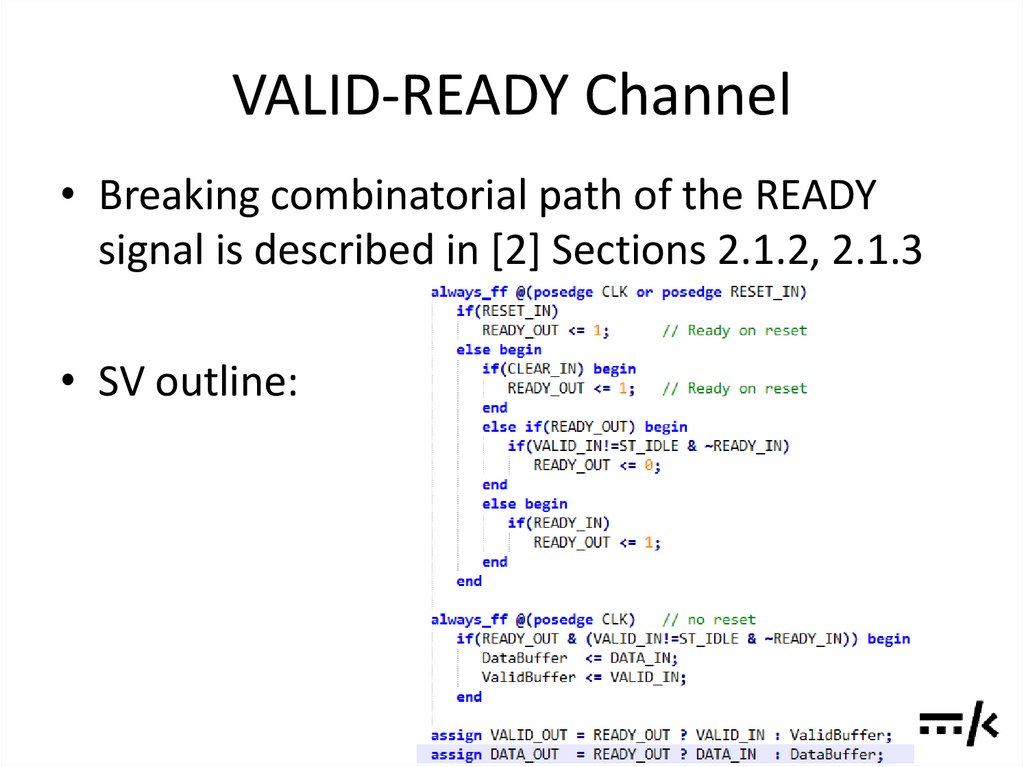
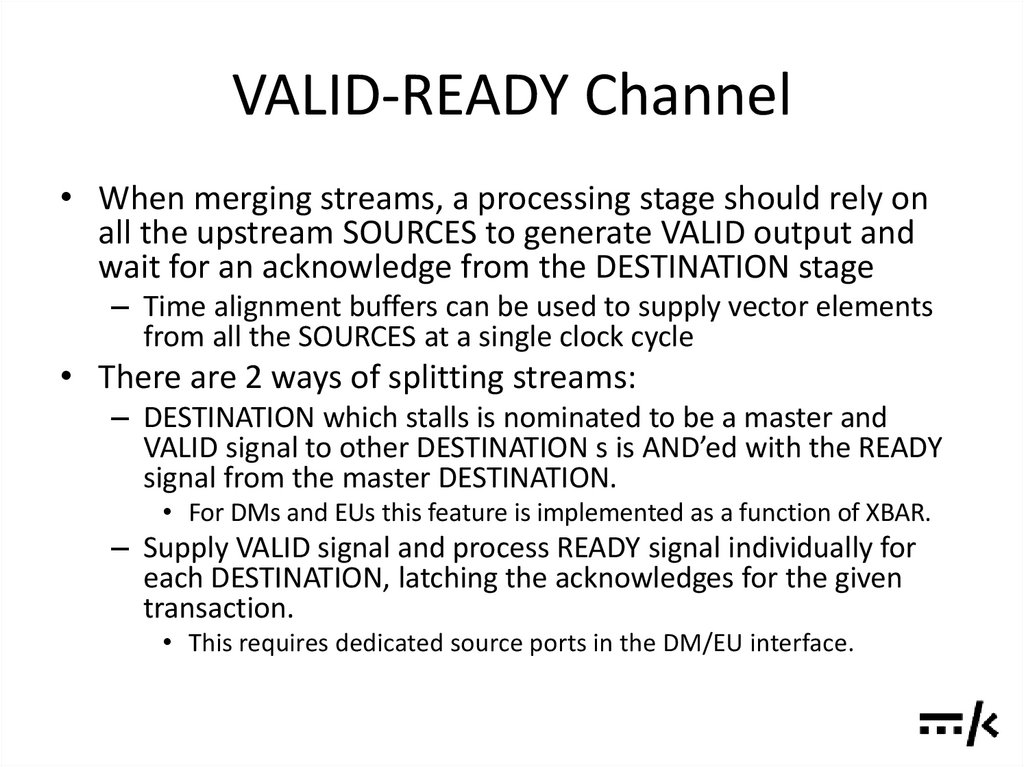



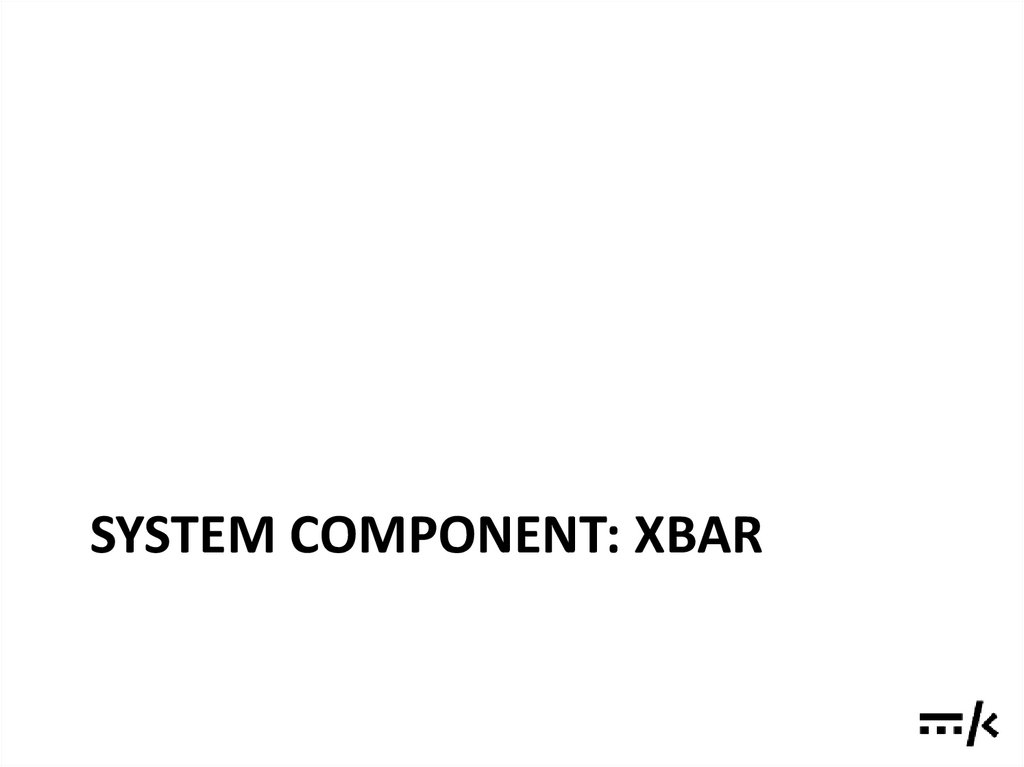

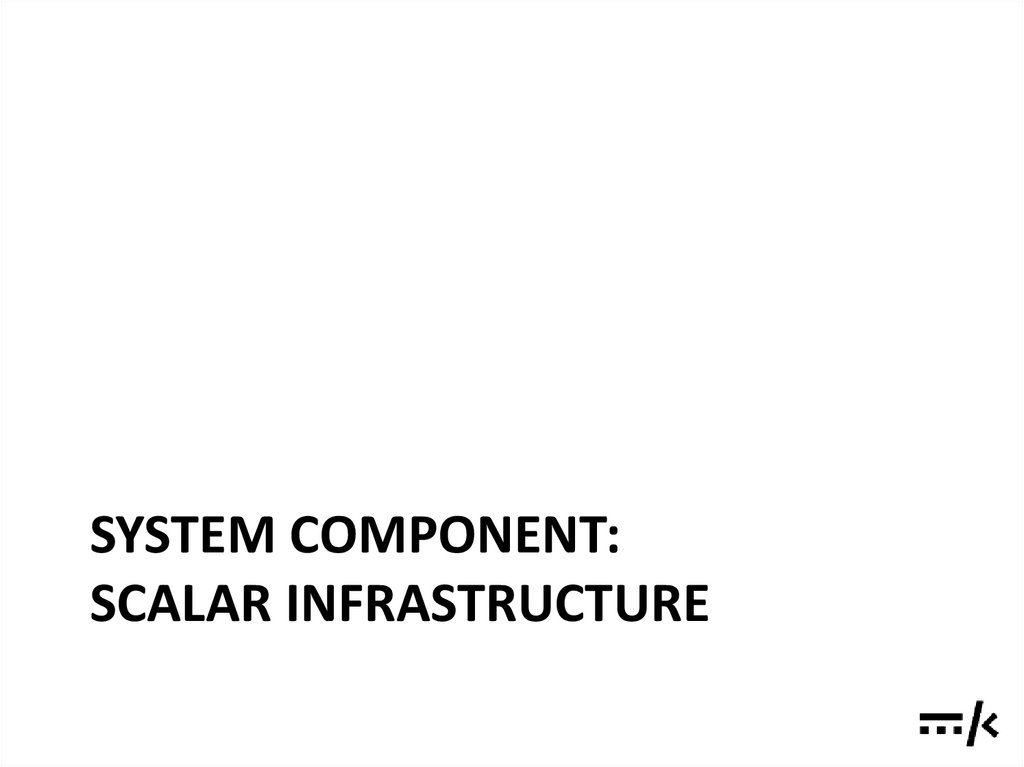









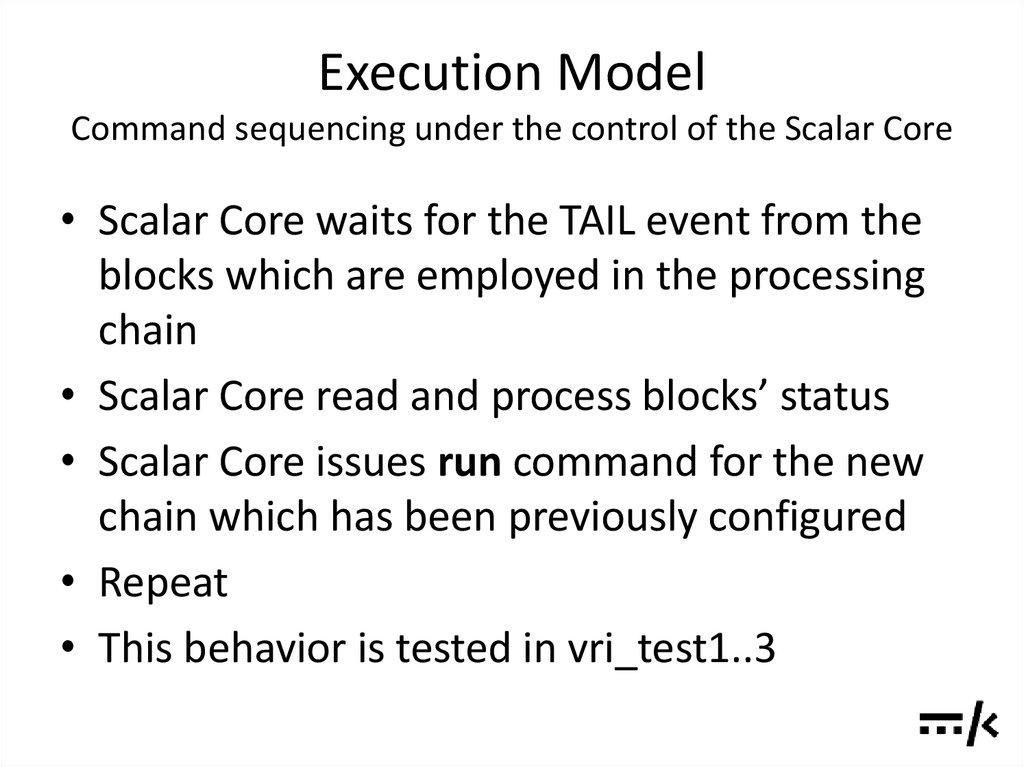












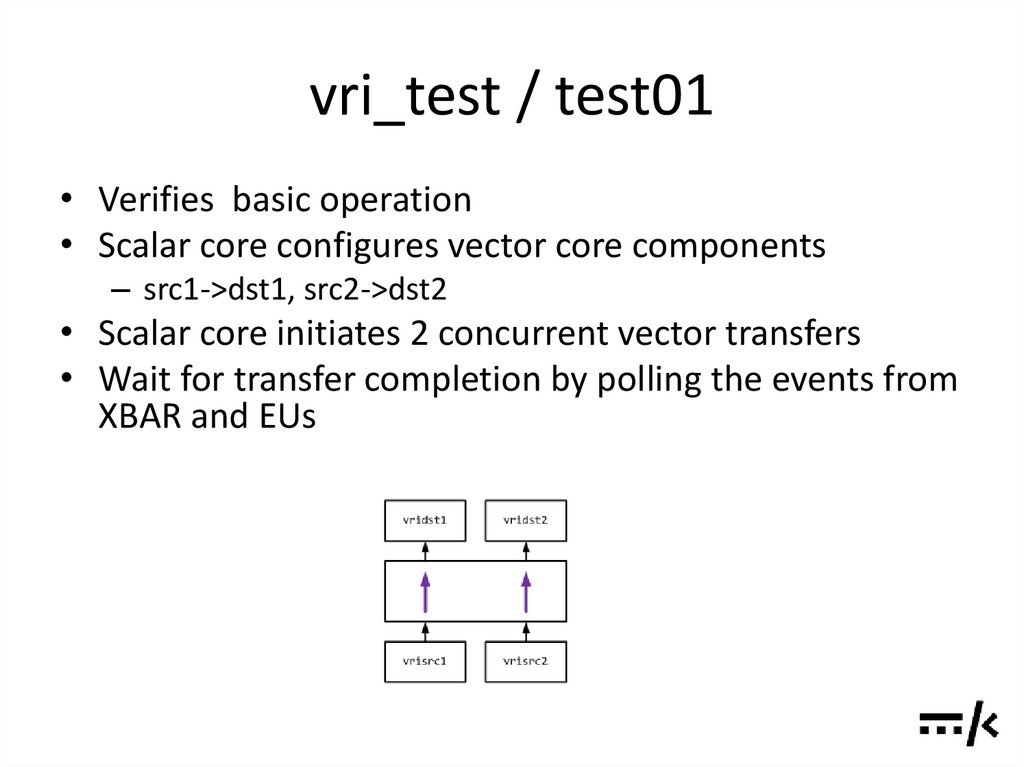






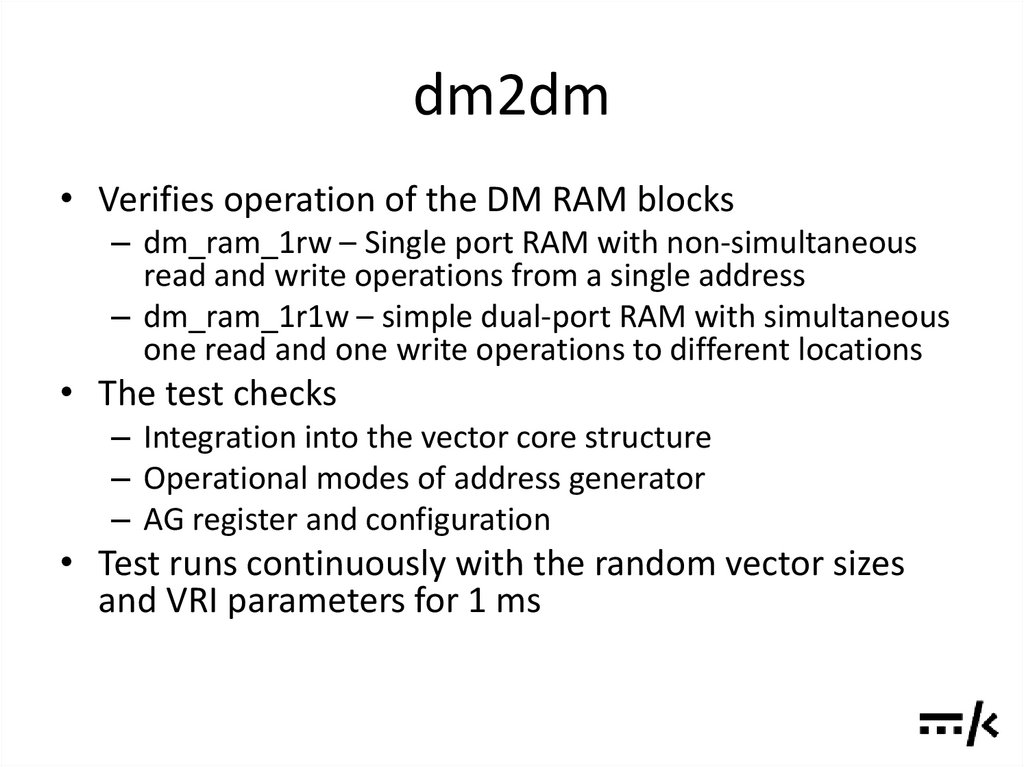

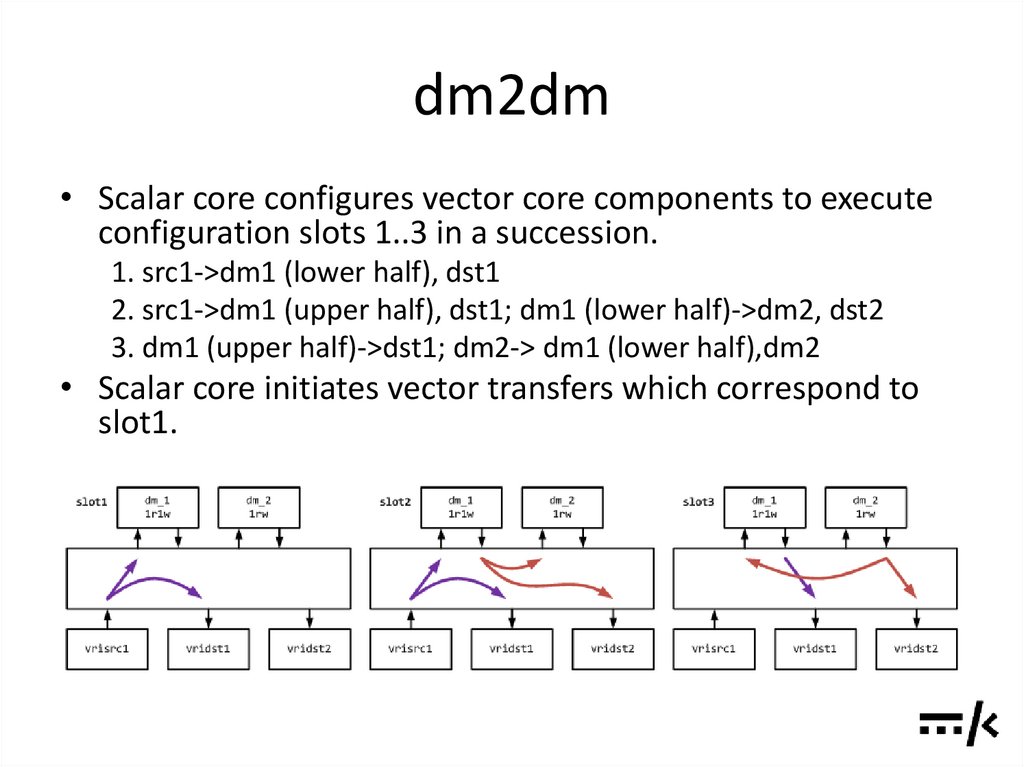


















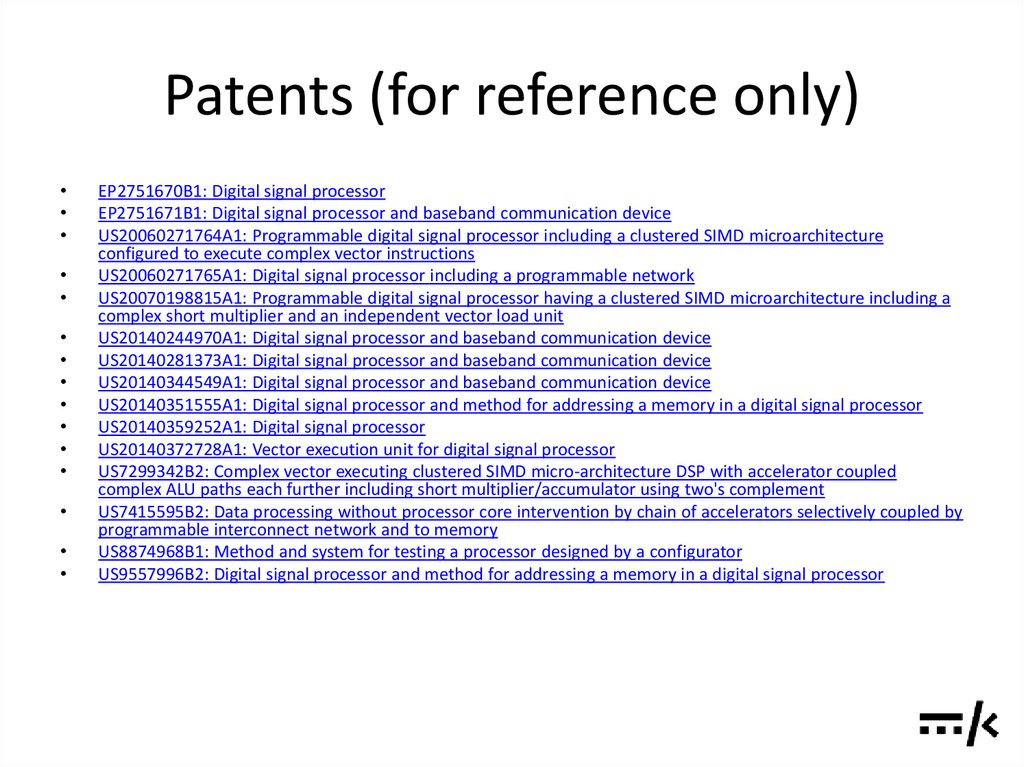
 programming
programming








